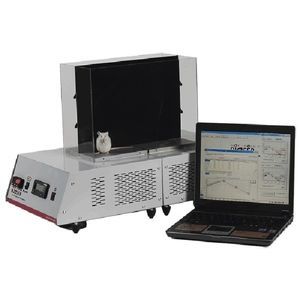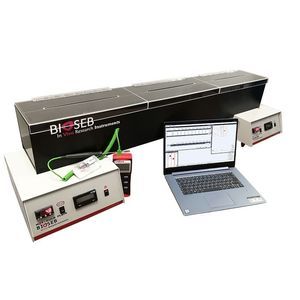
Animal research analgesiometer BIO-JTETfor micehotplatecold plate

Add to favorites
Compare this product
Characteristics
- Applications
- for animal research
- Animal type
- for mice
- Other characteristics
- cold plate, hotplate
Description
The "jump to escape" test is an entirely new set-up for the evaluation of the escaping behaviour of mice experimenting a ramp of cold and hot temperatures over an aluminium plate: it allows you to differentiate thermal allodynia from hyperalgesia in models of peripheral pain sensitization for mice. A must for your research on analgesia, especially to measure pharmacological effects of cancer treatment, including chemotherapy-induced neuropathy.
Following the publications of I. Yalcin et al. (The Journal of Pain, 2009) and complementary works from team of Dr Bourinet (EMBO J.Descoeur et al, 2011) regarding hypersensitivity to cold stimulus, BIOSEB has developed an entirely new set-up for the evaluation of the escaping behaviour of mice experimenting a ramp of temperature (cold and hot) over an aluminium plate.
The entire instrument is based on our popular Hot and cold Plate hardware, built around a metal plate which can be heated to 65°C and cooled to -3°C (with an ambient temperature between 20°C and 25°C), which already opened new investigation fields for your analgesia and nociception research. The classical setting is completed with a special back lighting plate and a HD camera sensitive to the back light wavelength placed in front of the Hot and Cold Plate.
The test has been mostly used to measure pharmacological effects of cancer treatment to cold sensitivity on mice.
Catalogs
No catalogs are available for this product.
See all of Bioseb‘s catalogsRelated Searches
- Analysis software
- Thermometer
- SpO2 monitor
- Control software
- Digital thermometer
- Laboratory software
- Windows software
- Electronic ventilator
- Automated software
- Infrared thermometer
- Monitoring software
- Acquisition software
- Tracking software
- Non-contact thermometer
- Portable ventilator
- Recording software
- Vital signs monitoring device
- Compact pulse oximeter
- Import software
- Probe thermometer
*Prices are pre-tax. They exclude delivery charges and customs duties and do not include additional charges for installation or activation options. Prices are indicative only and may vary by country, with changes to the cost of raw materials and exchange rates.





